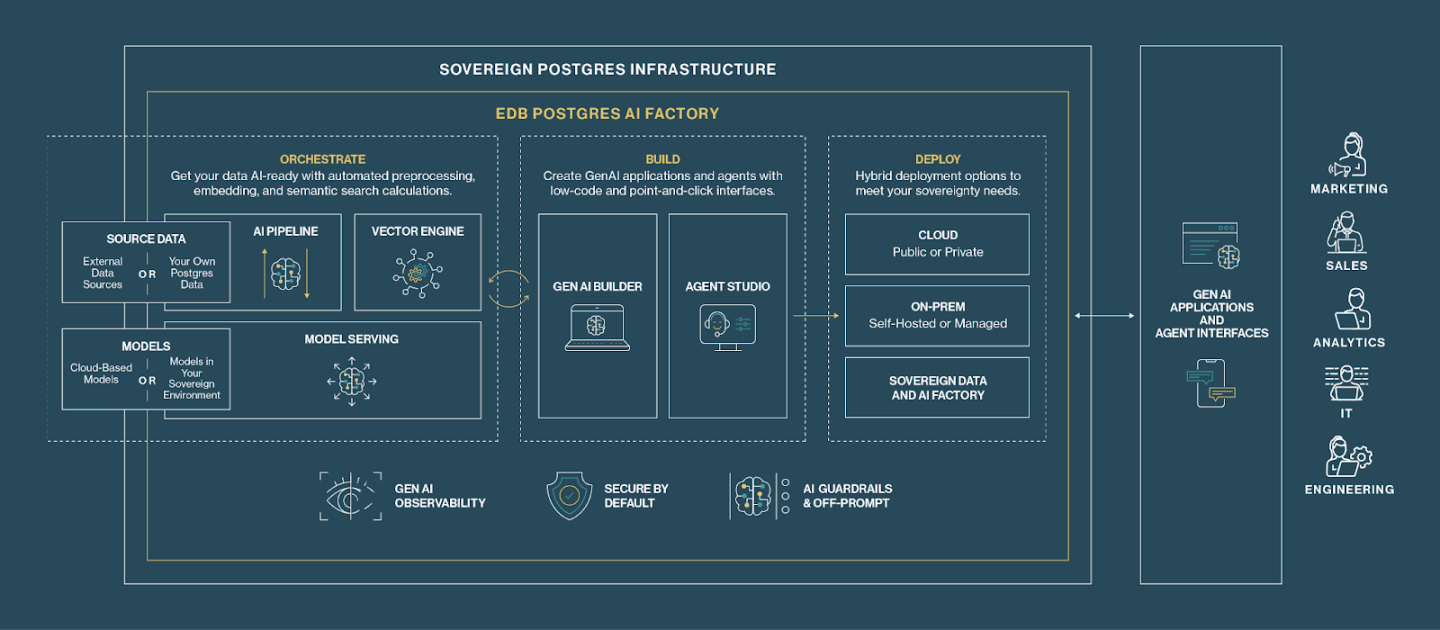Why only 13% of enterprises are winning with AI and data sovereignty—and how you can too

Sovereignty over AI and data is no longer a theoretical debate. It’s a defining business imperative.
Across 13 major economies representing more than $48 trillion in collective GDP, EDB’s global Sovereignty Matters research shows that 67% of enterprises view AI and data sovereignty as mission-critical within the next 1,000 days. Yet only 13% are doing it well enough to see transformative results—achieving five times the return on investment (ROI), two times the adoption of agentic and generative AI (gen AI), and two-and-a-half times the innovation performance of their peers.
So, what separates this 13% from the rest? After analyzing 15,000 simulations across 500 variables, EDB found five foundational DNA components that consistently emerged. These elements are not abstract theories. They are patterns of deliberate behavior that can influence whether enterprises position themselves as leaders or risk falling behind.
As Kevin Dallas, CEO of EDB, puts it: “Despite the buzz, data and AI sovereignty is still more storytelling than strategy. The winners aren’t louder, they’re just more deliberate.”
1. Make AI and data sovereignty mission critical, not optional
The first and most decisive factor is intent. When asked to rate the importance of AI and data sovereignty on a scale of one to seven, organizations that scored at six or seven (signaling “mission critical”) had a 90% greater chance of future confidence and economic resilience.
“The enterprises seeing real returns from agentic and gen AI have something in common, devoid of industry or region: They’ve made sovereignty over their AI and data a platform choice, not an afterthought,” said Dallas. “These leaders are building architectures designed to scale intelligence securely across hybrid environments. That’s what enables them to democratize agentic AI throughout their organizations while meeting enterprise and national requirements for trust, agility, and control.”

Kevin Dallas, CEO of EDB (Source: EDB)
In its research, EDB identified a small global sample of 30,497 enterprises (out of 134,000) that are “deeply committed” right now. These include businesses that are already embedding sovereignty into the heart of their business models. Their conviction—treating sovereignty as a must-have rather than a nice-to-have—sets the foundation for every other success factor.
Ask yourself: If sovereignty defines the future of competitive advantage, is your enterprise scoring a six or seven?
2. Democratize agentic and generative AI securely
The 13% are not dabbling. They are mainstreaming agentic and generative AI—deploying two times more use cases than their peers and doing so 50% faster, as shown by EDB’s Sovereignty Matters research. More importantly, they are pushing into next-generation applications such as digital twins, simulations, and agent-to-agent ecosystems that will define the future of AI-enabled operations.
Their secret? A low-code, no-code philosophy that empowers functions across the enterprise to build and use AI without waiting on scarce technical talent. By putting secure generative AI creation into the hands of the people and processes that matter, they unlock scale and accelerate the flywheel effect.
3. Build a platform, not pieces
Success is never an accident. The leading 13% blueprint sovereignty as a platform, not a collection of siloed tools. They design their large language models to be secure both in motion and at rest, ensure that data is available when and where it is needed, and embed sovereignty principles into every stage of the stack. Just as importantly, they align infrastructure with the needs of every team—linking security, observability, and agentic AI development into one integrated platform. This is what separates true sovereign architectures from fragmented experiments.

This AI factory brings together the AI pipeline, vector engine, model serving, and low-code development tools in a sovereign container. (Source: EDB)
4. Engineer “always-on” assurance
AI sovereignty isn’t just about compliance—it’s about resilience. For enterprises seeking to infuse AI into transactional, analytic, and autonomous workflows, five-nines availability (99.999%) becomes essential.
Generative and agentic AI thrive in real-timeenvironments. Without 24/7/365assurance across clouds, software, and hardware, sovereignty collapses under the weight of latency, outages, or inconsistency. Financial services firms already provide clear evidence of this truth: The company maintains that AI delivers its strongest value only when sovereignty is built in as a constant consideration.
5. Embed intelligent observability and governance
Finally, the 13% treat observability and governance as the production line of AI. They implement intelligent observability across hybrid and open-source environments, ensuring data flows seamlessly out of silos while staying secure and compliant.
This observability layer enables real-time governance of custom LLMs, CI/CD pipelines, and hybrid deployments. In fact, EDB’s research found that more than 40% of this thriving 13% use hybrid models anchored in Postgres as their sovereign data layer, combining resilience, agility, and compliance in one foundation.
In the company’s view, sovereignty is central to achieving compounding benefits: Without this DNA, there is no flywheel effect. With it, enterprises unlock scale, confidence, and long-term differentiation.
The future shape of success
What makes the 13% especially formidable is not only what they are achieving today, but how they are preparing for tomorrow. They are two times more likely to design AI infrastructure around energy efficiency, recognizing both economic and environmental imperatives. They are embedding sovereignty into their long-term strategy, not just this quarter’s roadmap.
As Jensen Huang, CEO of Nvidia, warns: “Sovereign AI is an imperative—no company, industry, or nation can outsource its intelligence.”
The company argues that the lesson is clear. Sovereignty is no longer optional. It is the North Star separating future leaders from laggards. For enterprises wrestling with how to make sovereignty real, the DNA of the 13% provides a blueprint:
- Treat sovereignty as mission critical.
- Democratize secure agentic and generative AI.
- Build platforms, not silos.
- Engineer always-on assurance.
- Embed intelligent observability and governance.
Just as the three waves of digital transformation reshaped industries in past decades, sovereignty will define the winners of the AI era. The challenge for every chief data officer, chief information officer, and CEO is simple: Will you wait three years, or will you act now?
Note: This content was created by EDB.